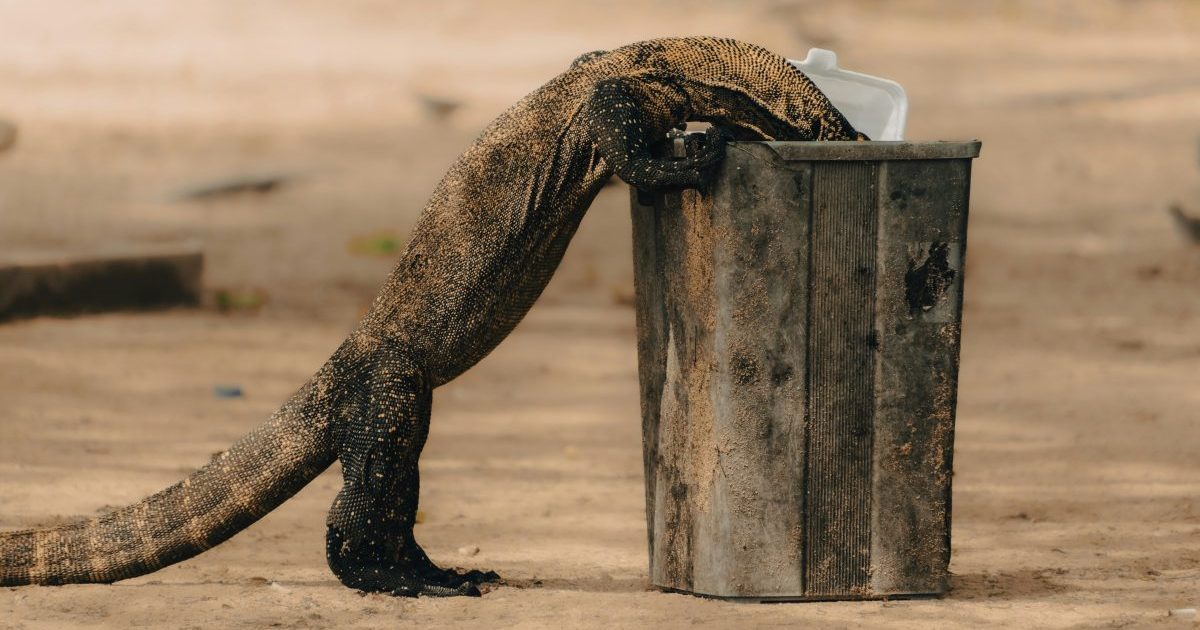
The ultimate killing machine? It might well be the Komodo dragon.
Arguably the closest survivor to a living tyrannosaur in body and behavior, though not genetics, Komodo dragons (Varanus komodoensis), are the largest living lizard on earth. Their kill rate is the best in the animal kingdom, and a new discovery may mean they are the best of all time, too.
Known for serrated, curved teeth, a new study shows the tips and cutting edges are enriched in iron. This explains how their teeth remain capable of pulling prey apart despite an enamel coating much thinner than in mammals.
There’s also now reason to suspect predatory dinosaurs, such as the Tyrannosaurus Rex, may have used the same trick to puncture and pull prey apart with extra speed. Komodos are not the only animal to strengthen their teeth with the addition of the metal. Chitons like Cryptochiton stelleri, a type of mollusk, have also adopted the idea, though they are not known as terrifying predators. They use the iron to bolster teeth that allow them to collect algae and bacteria by scraping them against rocks.
Iron is actually a common feature in reptilian teeth, but only in small concentrations.
However, Komodo dragons take this a stage further by concentrating the iron where it counts, sequestering iron into a discrete coating along the serrated edges. This innovation keeps the serrated edges of dragon teeth sharper than would otherwise be possible.
The shape of Komodo dragons’ teeth and that of the larger predatory dinosaurs, like the T-Rex, is very similar, as has been previously noted. It is therefore natural for researchers to wonder if T-Rex teeth were iron-tipped, too.
“Unfortunately, using the technology we have at the moment, we can’t see whether fossilized dinosaur teeth had high levels of iron or not. We think that the chemical changes which take place during the fossilization process obscure how much iron was present to start with,” said Dr Aaron LeBlanc of King’s College London in a statement.
“What we did find, though, was that larger meat-eating dinosaurs, like tyrannosaurs, did change the structure of the enamel itself on the cutting edges of their teeth. So, while Komodo dragons have altered the chemistry of their teeth, some dinosaurs altered the structure of their dental enamel to maintain a sharp cutting edge,” LeBlanc said.
LeBlanc and his team are continuing to research whether dinosaur teeth might indeed share the iron-tipped too, and with DNA technology regularly improving, they may eventually be able to answer the question.
“With further analysis of the Komodo teeth we may be able to find other markers in the iron coating that aren’t changed during fossilization,” he said. Some such markers might survive fossilization, providing an answer to the dinosaur question.
The team are also investigating some of Komodo dragons’ closest relatives, including some extinct giants.
The size, speed, and fearsome teeth of Komodo dragons are not their only weaponry. They have also have a layer of bony armor under their scales that has been compared to chain mail.
There is also their deadly venom, which ironically could prove a lifesaver for stroke victims, and blood with powerful antibiotic capacities, additional weapons that make them quite possibly the world’s deadliest predator.
Thankfully for the rest of the animal kingdom, they are also quite the homebodies, refusing to stray hard from their island habitats. Having such a limited range means that changes to their environment have put them on the endangered species list as their prey has become limited as well.
The Komodo dragon was already fearsome enough, but with its iron-tipped teeth, it becomes the world’s apex predator.
Thought that was fascinating? Here’s another story you might like: Why You’ll Never See A Great White Shark In An Aquarium